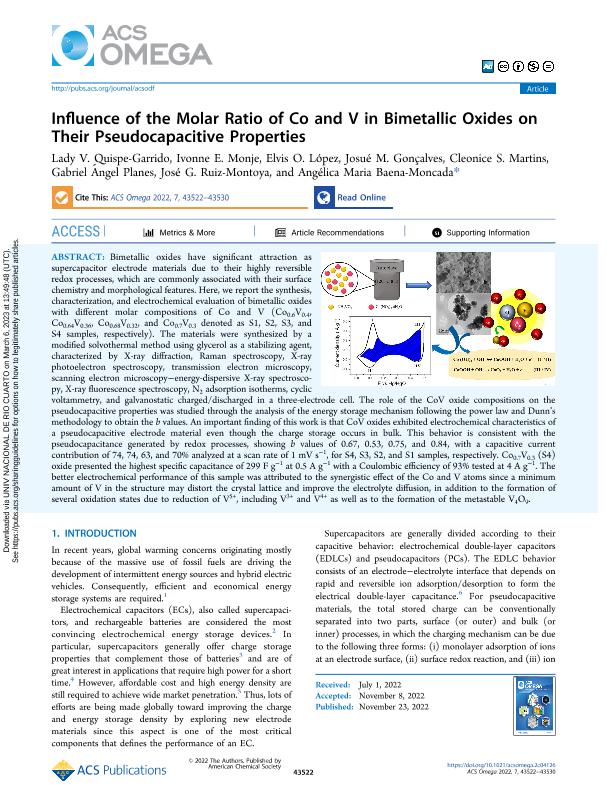Mostrar el registro sencillo del ítem
dc.contributor.author
Quispe Garrido, Lady V.
dc.contributor.author
Monje, Ivonne E.
dc.contributor.author
López, Elvis O.
dc.contributor.author
Gonçalves, Josué M.
dc.contributor.author
Martins, Cleonice S.
dc.contributor.author
Planes, Gabriel Angel

dc.contributor.author
Ruiz Montoya, José G.
dc.contributor.author
Baena Moncada, Angelica Maria

dc.date.available
2023-07-24T16:51:47Z
dc.date.issued
2022-12
dc.identifier.citation
Quispe Garrido, Lady V.; Monje, Ivonne E.; López, Elvis O.; Gonçalves, Josué M.; Martins, Cleonice S.; et al.; Influence of the molar ratio of co and v in bimetallic oxides on their pseudocapacitive properties; American Chemical Society; ACS Omega; 7; 48; 12-2022; 43522-43530
dc.identifier.uri
http://hdl.handle.net/11336/205070
dc.description.abstract
Bimetallic oxides have significant attraction as supercapacitor electrode materials due to their highly reversible redox processes, which are commonly associated with their surface chemistry and morphological features. Here, we report the synthesis, characterization, and electrochemical evaluation of bimetallic oxides with different molar compositions of Co and V (Co0.6V0.4, Co0.64V0.36, Co0.68V0.32, and Co0.7V0.3 denoted as S1, S2, S3, and S4 samples, respectively). The materials were synthesized by a modified solvothermal method using glycerol as a stabilizing agent, characterized by X-ray diffraction, Raman spectroscopy, X-ray photoelectron spectroscopy, transmission electron microscopy, scanning electron microscopy-energy-dispersive X-ray spectroscopy, X-ray fluorescence spectroscopy, N2 adsorption isotherms, cyclic voltammetry, and galvanostatic charged/discharged in a three-electrode cell. The role of the CoV oxide compositions on the pseudocapacitive properties was studied through the analysis of the energy storage mechanism following the power law and Dunn's methodology to obtain the b values. An important finding of this work is that CoV oxides exhibited electrochemical characteristics of a pseudocapacitive electrode material even though the charge storage occurs in bulk. This behavior is consistent with the pseudocapacitance generated by redox processes, showing b values of 0.67, 0.53, 0.75, and 0.84, with a capacitive current contribution of 74, 74, 63, and 70% analyzed at a scan rate of 1 mV s-1, for S4, S3, S2, and S1 samples, respectively. Co0.7V0.3 (S4) oxide presented the highest specific capacitance of 299 F g-1 at 0.5 A g-1 with a Coulombic efficiency of 93% tested at 4 A g-1. The better electrochemical performance of this sample was attributed to the synergistic effect of the Co and V atoms since a minimum amount of V in the structure may distort the crystal lattice and improve the electrolyte diffusion, in addition to the formation of several oxidation states due to reduction of V5+, including V3+ and V4+ as well as to the formation of the metastable V4O9.
dc.format
application/pdf
dc.language.iso
eng
dc.publisher
American Chemical Society
dc.rights
info:eu-repo/semantics/openAccess
dc.rights.uri
https://creativecommons.org/licenses/by-nc-sa/2.5/ar/
dc.subject
Electrodes
dc.subject
Oxides
dc.subject
Electrical Properties
dc.subject
Materials
dc.subject.classification
Físico-Química, Ciencia de los Polímeros, Electroquímica

dc.subject.classification
Ciencias Químicas

dc.subject.classification
CIENCIAS NATURALES Y EXACTAS

dc.title
Influence of the molar ratio of co and v in bimetallic oxides on their pseudocapacitive properties
dc.type
info:eu-repo/semantics/article
dc.type
info:ar-repo/semantics/artículo
dc.type
info:eu-repo/semantics/publishedVersion
dc.date.updated
2023-07-20T15:58:26Z
dc.identifier.eissn
2470-1343
dc.journal.volume
7
dc.journal.number
48
dc.journal.pagination
43522-43530
dc.journal.pais
Estados Unidos

dc.description.fil
Fil: Quispe Garrido, Lady V.. Universidad Nacional de Ingeniería. Electroquímica Aplicada, Facultad de Ciencias. Laboratorio de Investigación Electroquímica Aplicada; Perú
dc.description.fil
Fil: Monje, Ivonne E.. Universidad Nacional de Ingeniería. Electroquímica Aplicada, Facultad de Ciencias. Laboratorio de Investigación Electroquímica Aplicada; Perú
dc.description.fil
Fil: López, Elvis O.. Centro Brasileiro de Pesquisas Físicas; Brasil
dc.description.fil
Fil: Gonçalves, Josué M.. Universidade de Sao Paulo; Brasil
dc.description.fil
Fil: Martins, Cleonice S.. Centro Brasileiro de Pesquisas Físicas; Brasil
dc.description.fil
Fil: Planes, Gabriel Angel. Universidad Nacional de Río Cuarto; Argentina. Universidad Nacional de Río Cuarto. Facultad de Ciencias Exactas Fisicoquímicas y Naturales. Instituto de Investigaciones en Tecnologías Energéticas y Materiales Avanzados. - Consejo Nacional de Investigaciones Científicas y Técnicas. Centro Científico Tecnológico Conicet - Córdoba. Instituto de Investigaciones en Tecnologías Energéticas y Materiales Avanzados; Argentina
dc.description.fil
Fil: Ruiz Montoya, José G.. Universidad Nacional de Ingeniería. Electroquímica Aplicada, Facultad de Ciencias. Laboratorio de Investigación Electroquímica Aplicada; Perú
dc.description.fil
Fil: Baena Moncada, Angelica Maria. Universidad Nacional de Ingeniería. Electroquímica Aplicada, Facultad de Ciencias. Laboratorio de Investigación Electroquímica Aplicada; Perú. Universidad Nacional de Río Cuarto. Facultad de Ciencias Exactas Fisicoquímicas y Naturales. Instituto de Investigaciones en Tecnologías Energéticas y Materiales Avanzados. - Consejo Nacional de Investigaciones Científicas y Técnicas. Centro Científico Tecnológico Conicet - Córdoba. Instituto de Investigaciones en Tecnologías Energéticas y Materiales Avanzados; Argentina
dc.journal.title
ACS Omega
dc.relation.alternativeid
info:eu-repo/semantics/altIdentifier/doi/http://dx.doi.org/10.1021/acsomega.2c04126
dc.relation.alternativeid
info:eu-repo/semantics/altIdentifier/url/https://pubs.acs.org/doi/10.1021/acsomega.2c04126
Archivos asociados
